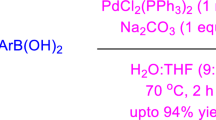Abstract
In the transition metal-catalyzed cross-coupling reactions, phenol and enol derivatives activated by phosphorus groups are very important electrophiles. This kind of compounds has the advantages of easy preparation, great stability, and producing more benign phosphorus by-products. The present work provides a comprehensive review of the advances made over the past several decades in this area. Cross-coupling reactions mediated by PyBroP are first surveyed, then two types of recently developed transition metal-catalyzed reactions, i.e., Pd-catalyzed and Ni-catalyzed reactions, and the corresponding mechanisms are discussed. Finally, future directions are analyzed.














Similar content being viewed by others
References
Mansour TS, Bardhan S, Wan ZK (2010) Phosphonium- and benzotriazolyloxy-mediated bond-forming reactions and their synthetic applications. Synlett 8:1143–1169
Kang FA, Sui ZH, Murray WV (2009) Phosphonium coupling in the direct bond formations of tautomerizable heterocycles via C–OH bond activation. Eur J Org Chem 4:461–479
ElMarrouni A, Fabrellas JM, Heras M (2011) Coupling reaction between electron-rich pyrimidinones and α-amino acids promoted by phosphonium salts. Org Biomol Chem 9:5967–5977
Castro B, Dormoy JR, Evin G et al (1975) Reactifs de couplage peptidique IV (1)—l′hexafluorophosphate de benzotriazolyl N-oxytrisoimethylamino phosphonium (B. O. P). Tetrahedron Lett 16:1219–1222
Coste J, Frerot E, Jouin P (1994) Coupling N-methylated amino acids using PyBroP and PyCloP halogenophosphonium salts: mechanism and fields of application. J Org Chem 59:2437–2446
Campagne JM, Coste J, Jouin P (1995) (1H-Benzotriazol-1-yloxy)tris(dimethylamino)-phosphonium hexafluorophosphate- and (1H-benzotriazol-1-yloxy)tripyrrolidinophosphonium hexafluorophosphate-mediated activation of monophosphonate esters: synthesis of mixed phosphonate diesters, the reactivity of the benzotriazolyl phosphonic esters vs the reactivity of the benzotriazolyl carboxylic esters. J Org Chem 60:5214–5223
Kim MH, Patel DV (1994) “BOP” as a reagent for mild and efficient preparation of esters. Tetrahedron Lett 35:5603–5606
Coste J, Campagne JM (1995) A propos de l’estérification des acides carboxyliques par le BOP ou le PyBOP. Tetrahedron Lett 36:4253–4256
Castro B, Chapleur Y, Gross B et al (1972) Sels d’alkyloxyphosphonium III—activation selective de l’hydroxyle primaire du methyl, α-d-glucopyrannoside. Tetrahedron Lett 13:5001–5004
Castro B, Selve C (2010) Sels d’alkyloxyphosphonium. VI—nouvelle preparation des dialkyl-3,3 oxetannes. Tetrahedron Lett 14:4459–4460
Downie IM, Heaney H, Kemp G (1988) Preparation of alkyl–aryl ethers and thioethers. Tetrahedron 44:2619–2624
Roncalil J (1997) Synthetic principles for bandgap control in linear π-conjugated systems. Chem Rev 97:173–205
Littke AF, Fu GC (2002) Palladium-catalyzed coupling reactions of aryl chlorides. Angew Chem Int Ed Engl 41:4176–4211
Hassan J, Sevignon M, Gozzi C et al (2002) Aryl–aryl bond formation one century after the discovery of the Ullmann reaction. Chem Rev 102:1359–1469
Horton DA, Bourne GT, Smythe ML (2003) The combinatorial synthesis of bicyclic privileged structures or privileged substructures. Chem Rev 103:893–930
Yao ML, Wang JP, Deng MZ (2001) Cross-coupling reaction of cyclopropylboronic acids with aryl ω-halo-oxo-perfluoroalkylsulfonates. Chin Sci Bull 46:1277–1281
Kang FA, Sui ZH, Murray WV (2008) Pd-catalyzed direct arylation of tautomerizable heterocycles with aryl boronic acids via C–OH bond activation using phosphonium salts. J Am Chem Soc 130:11300–11302
Kang FA, Lanter JC, Cai CZ et al (2010) Direct dehydrative cross-coupling of tautomerizable heterocycles with alkynes via Pd/Cu-catalyzed phosphonium coupling. Chem Commun 46:1347–1349
Shi C, Aldrich CC (2010) Efficient Pd-catalyzed coupling of tautomerizable heterocycles with terminal alkynes via C–OH bond activation using PyBroP. Org Lett 12:2286–2289
Mehta VP, Modha SG, Van der Eycken EV (2010) Microwave-assisted palladium-catalyzed phosphonium coupling of 2(1H)-pyrazinones. J Org Chem 75:976–979
Sharma A, Vachhani D, Van der Eycken E (2012) Direct heteroarylation of tautomerizable heterocycles into unsymmetrical and symmetrical biheterocycles via Pd/Cu-catalyzed phosphonium coupling. Org Lett 14:1854–1857
Rappoport Z (2003) The chemistry of phenols. Wiley, Chichester
Miyaura N, Suzuki A (1995) Palladium-catalyzed cross-coupling reactions of organoboron compounds. Chem Rev 95:2457–2483
Chen GJ, Huang J, Gao LX et al (2011) Nickel-catalyzed cross-coupling of phenols and arylboronic acids through an in situ phenol activation mediated by PyBroP. Chem Eur J 17:4038–4042
Li SM, Huang J, Chen GJ et al (2011) PdCl2(dppf)-catalyzed in situ coupling of 2-hydroxypyridines with aryl boronic acids mediated by PyBroP and the one-pot chemo- and regioselective construction of two distinct aryl–aryl bonds. Chem Commun 47:12840–12842
Evans OR, Manke DR, Lin W (2002) Homochiral metal-organic frameworks based on transition metal bisphosphonates. Chem Mater 14:3866–3874
Jin S, Gonsalves KE (1998) Synthesis and characterization of functionalized poly(ε-caprolactone) copolymers by free-radical polymerization. Macromolecules 31:1010–1015
Dang Q, Liu Y, Cashion DK et al (2011) Discovery of a series of phosphonic acid-containing thiazoles and orally bioavailable diamide prodrugs that lower glucose in diabetic animals through inhibition of fructose-1,6-bisphosphatase. J Med Chem 54:153–165
Birkholz MN, Freixa Z, van Leeuwen PWNM (2009) Bite angle effects of diphosphines in C–C and C–X bond forming cross coupling reaction. Chem Soc Rev 38:1099–1118
Glueck DS (2008) Catalytic asymmetric synthesis of chiral phosphanes. Chem Eur J 14:108–7117
Zhao YL, Wu GJ, Han FS (2012) Ni-catalyzed construction of C–P bonds from electron-deficient phenols via the in situ aryl C–O activation by PyBroP. Chem Commun 48:5868–5870
Acknowledgments
This work was supported by the Public Welfare Technology Applied Project of Lishui City (2012JYZB32).
Author information
Authors and Affiliations
Corresponding authors
About this article
Cite this article
Chen, G., Du, J. Progress of transition metal-catalyzed cross-coupling mediated by PyBroP. Chin. Sci. Bull. 59, 1942–1949 (2014). https://doi.org/10.1007/s11434-014-0239-0
Received:
Accepted:
Published:
Issue Date:
DOI: https://doi.org/10.1007/s11434-014-0239-0




